The LSI 9300-4i4e is a host bus adapter (HBA) that offers next generation 12gbps SAS 3 connectivity. We have seen the higher-end server market move to higher performance interfaces for years now, and with the current generation of solid state drives, SAS 2 running at 6.0gbps was being saturated by many drives on the market. Unlike with mechanical drives, it is relatively easy to provide more performance from a SAS SSD and so SAS 2 was certainly holding the higher-end of the industry back in terms of performance. With the introduction of the LSI SAS 3008 and 3108 controllers, LSI is officially in the 12.0gbps SAS 3 game. Today we are looking at the LSI 9300-4i4e which provides both internal and external connectivity. Suffice to say, this card represents a new performance standard that we will see integrated in many servers going forward.
LSI 9300-4i4e Test Configuration
Unfortunately, SAS3 is not yet a widely deployed standard, either from the host side or from the drive side. For these tests we used the LSI 9300-4i4e in our dual Xeon E5 testbed.
- CPUs: 2x Intel Xeon E5-2690 CPUs
- Motherboard: Supermicro X9DRH-7TF
- Memory: 16x Samsung 16GB 1600MHz DDR3 ECC RDIMM
- SAS Controller: LSI 9300-4i4e
- SSDs: 4x Samsung 840 Pro 256GB 3x SanDisk Extreme II 240GB 1x Ultrastar HGST SSD800MM 400GB
- Operating System: Ubuntu 12.04 LTS and Windows Server 2012
Overall this is a strong test platform. A thank you should be given to the anonymous lender of the Ultrastar 12gbps SAS SSD used in this test. Certainly more testing is warranted as they become more commonplace.
The LSI 9300-4i4e HBA
Looking at the LSI 9300-4i4e we see a very familiar design. The SAS3008 controller at the heart of the card is covered by a moderate sized passive cooling solution. The card’s heatsink does require chassis airflow to keep the controller cool. The LSI 9300-4i4e review sample that we received utilized a full height bracket. It is easy to see that the card is meant to serve both full-height as well as half-height form factors with the appropriate bracket.
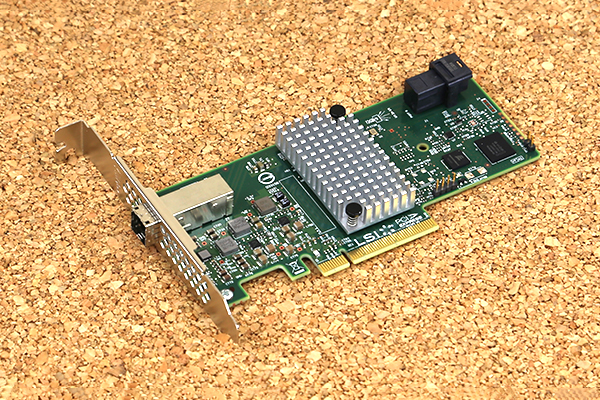
On the internal side, we find one of the newer generation SFF-8643 connectors. The SFF-8643 connector is the next-generation SAS connector that will be more commonplace on newer cards. Luckily, there are plenty of SFF-8643 to SFF-8087 cables available to convert in the meantime.
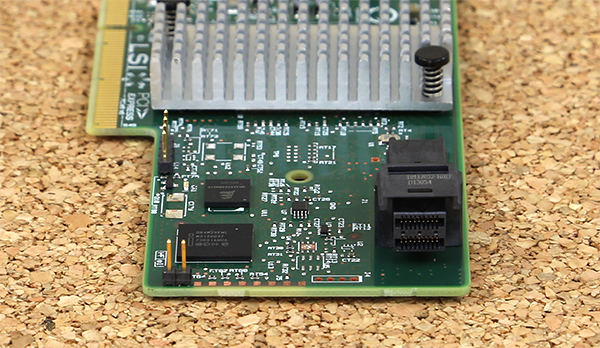
The external connector is a SFF-8644 connector. We highlighted this connector as being the next-generation form factor in our LSI 9202-16e article a long time ago. The simple reason that the industry is moving in this direction is that it allows for higher port density in the same connector plane. On a half-height expansion card, four of such ports can easily be used.
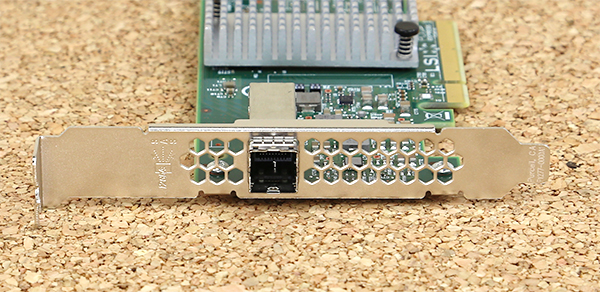
LSI 9300-4i4e Performance
For the tests, we were limited with only one 12gbps SAS SSD at this time. What was very telling is that the new interface clearly increases headroom substantially. We compared results with the LSI 9207-8i which is based on the SAS2308 controller, a second generation LSI SAS II 6.0gbps controller. The most telling difference came from the sequential performance numbers which were gated by the drive. Of course, we expect these numbers will go up over time as 12gbps SAS drives become more commonplace:
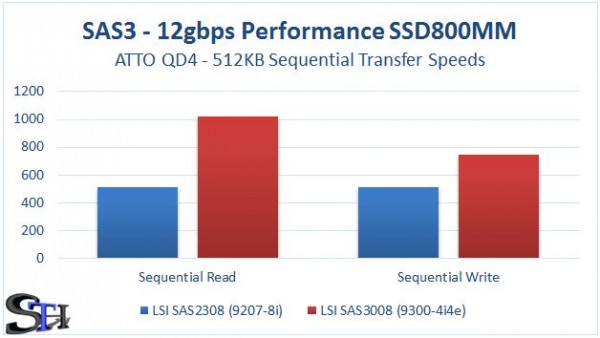
The graph is simple to read, the new interface clearly holds massive performance gains for read speeds. We saw almost 2x the sequential read speeds and about 50% higher write speeds on the newer controller. The LSI 9300-4i4e provides much more headroom than its predecessor on a per-drive basis. We also ran 4K IOPS using IOMeter while we had the drive and picked a Queue Depth of 32 to keep the controller and drive fed. Similarly, we saw an improvement:
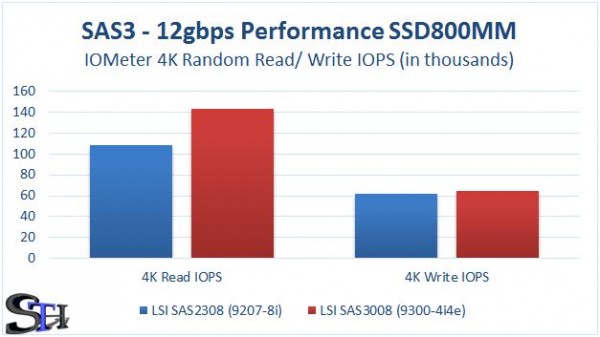
Even in a demanding test, the drive performs much better on the newer LSI 9300-4i4e controller. If you simply take 140,000 * 4KB / 1024KB/MB one gets over 500MB/s in random read performance.
Conclusion
Overall we can see the value presented by the LSI 9300-4i4e for those looking to create high-performance storage systems. One of the most exciting features of the LSI 9300-4i4e is the promise of the company’s new LSI DataBolt technology. LSI DataBolt technology can aggregate 6gbps and 3gbps devices into a 12gbps data stream. In theory, this technology with an accompanying 12gbps SAS expander would double the back-haul bandwidth of the disk shelf to the host server from today’s 6gbps standard to 12gbps. For those with arrays of 6gbps disks that choke a 6gbps uplink, DataBolt and the LSI 12gbps controllers have the potential to double the performance of existing investments. The 9300-4i4e benefits from this as it has four internal and four external ports. That means it has 48gbps available (4 ports * 12gbps per port) bandwidth to internal drives and external storage chassis. This is certainly something we will investigate more as more drives become available. We had a limited amount of time with the 12gbps SAS SSD but the performance is impressive. What is more impressive is that it is a first-generation product. In a year or two, we will have devices that can fully take advantage of the performance controllers like the LSI 9300-4i4e offer.





It will be some time before I start buying 12G SAS SSD drives, but I am very much looking forward to pairing a pile of 6G SSD drives with a 12G backplane and one of the new 12G SAS HBAs.
I am wanting to build out a solution with a 12g HBA and 12g backplane with 6g drives, but I am only finding backplanes that support 2.5 inch drives, no SAS3 for 3.5 inch drives. Anyone else find any backplane/expander that will support 3.5 inch drives?